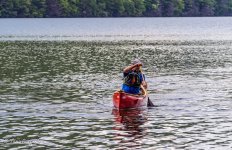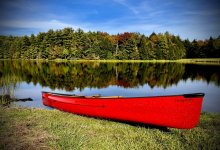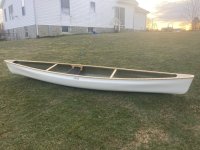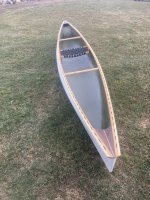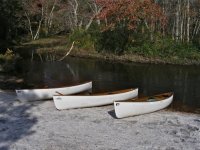It is interesting for someone to have both a Dragonfly and an SRT. These are both "Harold Deal canoes." The Dragonfly was conceptualized and designed by Harold (formal design lofting by Dave Yost) specifically as a canoe FOR HIM, an advanced paddler, to race in the whitewater combined class, in which the paddler uses the same canoe for both the slalom competition and the downriver competition. Most folks I knew other than Harold who bought the Dragonfly from Curtis in the 1980's used them as solo whitewater canoes.
Harold himself began to use the Dragonfly in the 1980's for many of his solo Canadian wilderness trips, many of which he photographed and wrote up in paddling journals. So, the Dragonfly also got sort of a reputation as a solo tripping canoe, but I don't think Curtis ever sold that many overall.
The Dragonfly has now become a sort historic of cult canoe, having been resurrected for a few boats by Colden and now by Swift. Those owners apparently like it a lot.
Harold wasn't satisfied with the Dragonfly after about 10 years. He felt the Dragonfly had flaws as a tripping canoe for rivers and lakes, especially when loaded with gear, unlike a whitewater race in which the canoe is paddled unladen. He also felt the Dragonfly had flaws as a solo whitewater play canoe. Therefore, in the early 90's, Harold designed both the Shaman as a dedicated solo whitewater play canoe, and also the SRT as a tripping canoe that could be efficiently paddled on Canadian whitewater rivers (class 2-3) as well as the interconnected Canadian lakes. The central three feet of the Shaman and the SRT hulls are actually identical. Because the SRT has whitewater potential, Harold paddled a stock SRT once in the U.S. Nationals downriver canoe class on the lower Yough and came in second.
I've heard Dave Curtis summarize the two canoes thusly: "The Dragonfly was designed as whitewater racing canoe that can be used for tripping, whereas the SRT was designed as a tripping canoe that can be used for downriver whitewater racing."
When Colden began making the Dragonfly in 2011, Harold apparently was asked a lot about the differences. He was not really interested in doing that, being a sort of quiet and humble guy, but he did write in his May 25, 2011, canoe history, from which I quoted extensively in
THIS THREAD, the following:
"My attention has been brought to recent internet chatter concerning the old Curtis Dragonfly, along with my name being tossed around on a number of occasions. In addition to inquiries I receive about the Hemlock SRT and Shaman, I’ve also been asked by individuals about my involvement with the Dragonfly.
. . . .
"It is likely that I paddled the Dragonfly for a wider range of uses and possibly have more hours in them than most anyone else and I'm certainly qualified to comment on it, but I’m not inclined to do that. I will say that I have not owned one in many years and do not miss paddling them."
For the rest of his life, as far as I know, Harold paddled his newer designs—the Shaman for serious whitewater play, and the SRT for long distance touring or simple day tripping on lakes and mild whitewater rivers.
Of course, we all prefer different boats, often at different points in our paddling careers. It wouldn't surprise me if someone liked the SRT more than the Dragonfly, or vice versa, or liked both equally. One of the perceived difficulties with the SRT among inexperienced paddlers is the initial tenderness, caused by the narrow waterline and rounded bottom, but Harold told me the Curtis Dragonfly was even more tender. Therefore, I suspect the SRT is more comfortable to paddle while sitting. In any event, if you can handle either canoe with confidence and skill, you are likely a pretty darn good paddler.
I suspect the SRT will also become a historic cult canoe once Dave Curtis stops making them.
